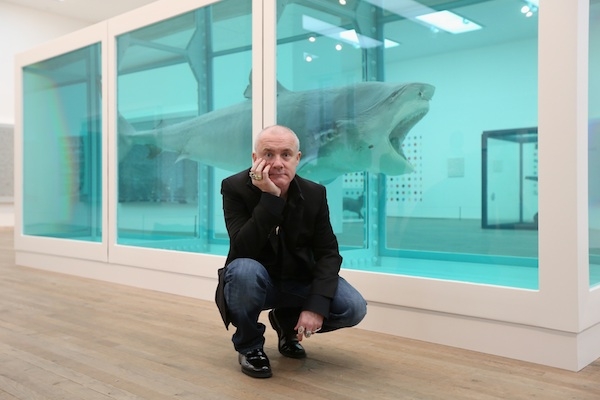What was shocking about Damien Hirst’s appearance on Desert Island Discs on Sunday was not his admission on air that he lost his £20,000 Turner Prize cheque, and then discovered he had spent it all in the Groucho Club bar. Or his account of his early teens drinking cider beneath the pylons, shoplifting, burgling, always in trouble. A boy for whom ‘Crime is creative’. No, what was truly surprising was just how predictable are his thoughts about his art, his success, his place in the cultural life of GB.
Hirst gave very little away, but not in an intriguing, there must be more going on underneath kind of way. The rigidly formulaic DID is not best designed for conversational revelations or deep-seated insights. Yet by the end of the programme it was impossible not to wonder: is this all there is behind the dots, dead cows, sharks and maggots?
When Kirsty Young asked Hirst how hard it was to give up drink and drugs after a half-lifetime of overuse, he replied that he had to learn how to be sober, how to socialise, how to be in a public situation. Then he added, ‘Especially being Damien Hirst was difficult.’ Young asked him what he meant by that. ‘It’s not who you are, it’s what you represent to people,’ he said, emphasising, ‘It’s important what you represent to people.’
Realising that she had hooked him, Young persisted. ‘What do you think you represent?’ Then adding, in explanation, ‘Culturally?’ Hirst was nonplussed, as if culture was not something he thought very much about. ‘It’s really important to me for art students to think I’m cool.’
Fantastic expectations were trailed for this programme, as if amazing revelations would be its fruit. All we got was the realisation that Hirst enjoys the sensation of manipulating people to believe what he wants them to believe. This is his one great creative insight.
Truly surprising, and much more entertaining, was Radio 3’s Sunday Feature, which this week investigated the life and work of Jan Morris, the journalist, historian of empire, traveller, writer and commentator. Jan Morris: Travels Round My House (produced by Sara Jane Hall) took us to Morris’s home, a converted barn in the remote countryside of north Wales, looking for objects that might explain the conundrums of her complicated personality. Why, for instance, does she keep a gravestone below stairs, etched ready and waiting for erection once she’s dead and gone?
Morris began life as James in 1926, and after a spell in the army as a Guardsman he studied at Christ Church, Oxford before joining the Times as a foreign correspondent. Then in May 1953 he was sent out to Kathmandu to report back on the attempt to conquer Everest by Edmund Hillary and Tenzing Norgay. Morris was the only journalist to get the story, ensuring that the news reached Buckingham Palace on the night before the Coronation, in time for printing in the Times the next morning. Afterwards, the Duke of Edinburgh apparently said, ‘It helped us to sleep easy that night,’ as if there was some kind of mythical connection between the mountain and the monarchy.
Anthony Sattin, who presented the programme, asked Morris (who became Jan after a gender reassignment operation in 1972) to explain how he had managed to secure the coup for the paper. At the time, Morris said, he had never been up a ‘serious’ mountain before, but was faced with climbing the treacherous two-mile Ice Fall that lay between Base Camp and Camp 4. It was the quickest way to get the news back to London in those days before satellite communications. Having made it through the ice, Morris had to wait for confirmation of Hillary and Tenzing’s success before hurrying back down through it to Base Camp, where he employed two runners to retrace on foot the 180 miles back to Kathmandu. Only then could his coded telegraph be transmitted back to London.
This was a scoop to outscoop all others. No other journalist ventured as he had done. Now 86, Morris’s excitement at what she had once done was palpable. ‘We went on down the Ice Fall together,’ she recalled, ‘through the developing dusk, with the news that only I knew. I had to get it through to London. The excitement of it. The romance of it. The Queen was going to be crowned. Can you imagine it all?’ Yet more astonishing is the fact that if Morris had been a woman in 1953 it’s doubtful whether she would have been trusted with such an assignment.
As for the gravestone? Like Hirst, Morris is obsessed by death, or rather mortality (not so long ago she suffered a terrible fall after tripping over her cat and had to undergo brain surgery — ‘Trepanning… like the Incas used to do’). ‘I don’t believe death has any importance,’ she says. ‘Bring it on.’ There’s the real conundrum: a woman who welcomes her own death yet still has more intense curiosity about the world around her than most people half her age.






Comments